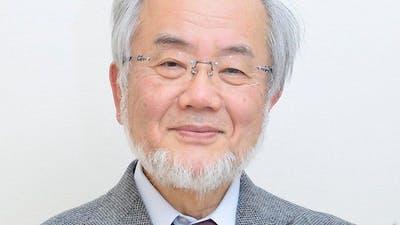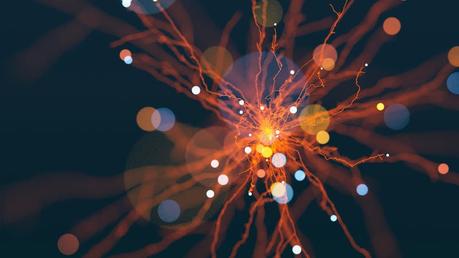
Simple single-celled organisms called prokaryotes, such as bacteria, are the earliest forms of life on earth, and still abundant today. Much later evolved the more complex, but still single-celled organisms called eukaryotes. From those humble beginnings came the multi-cellular life forms called metazoans.
All animal cells, including humans, are eukaryotic cells. Since they share a common origin, they bear a resemblance to each other. Many molecular mechanisms (genes, enzymes, etc.) and biochemical pathways are conserved throughout the evolution towards more complex organisms.
Humans share approximately 98.8% of their genes with chimpanzees. This 1.2% genetic difference is enough to account for the differences between the two species. It may be even more surprising, however, to learn that organisms as far apart as yeast and humans have many genes in common. At least 20% of genes in humans that play a role in causing disease have counterparts in yeast. When scientists spliced over 400 different human genes into the yeast Saccharomyces cerevisiae, they found that a full 47% functionally replaced the yeast's own genes.
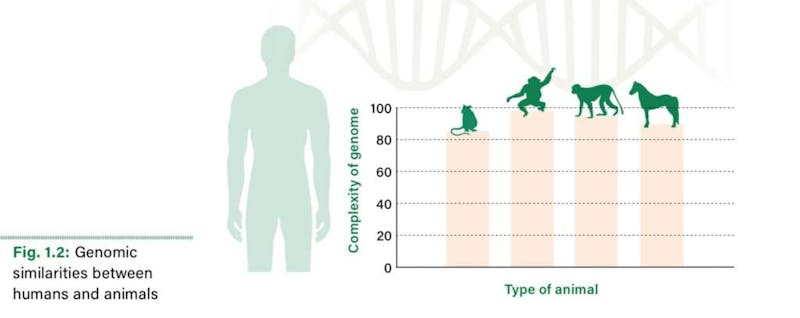
With more complex organisms, such as the mouse, we find even greater similarities. Of over 4,000 genes studied, less than ten were found to be different between humans and mice. Of all protein-coding genes - excluding the so-called "junk" DNA - the genes of mice and humans are 85% identical. Mice and humans are highly similar at the genetic level.
Many aging related genes are conserved throughout species enabling scientists to study yeast and mice to learn important lessons for human biology. Many of the studies cited in this book involve organisms as diverse as yeast, rats and rhesus monkeys, and all vary in the degree of their similarity to humans.
Not every result necessarily applies to humans, but in most cases the results will be close enough that you can learn a great deal about aging from them. While it is ideal to have human studies, in many cases, these simply do not exist, forcing us to rely on animal studies.
Theories of aging
Disposable soma
The disposable soma theory of aging, proposed originally by University of Newcastle professor Thomas Kirkwood, holds that organisms have a limited finite amount of energy that may be used in either maintenance and repair of the body (soma), or in reproduction. Like antagonistic pleiotropy, there is a trade-off: if you allocate energy to maintenance and repair, then you have fewer resources for reproduction.
Since evolution directs more energy towards reproduction, which helps propagate its genes to the next generation of organisms, the soma after reproduction is largely disposable. Why devote precious resources to living longer, which doesn't help passing on the gene? In some cases, the best strategy may be to have as many offspring as possible, and then for the individual to die.
The Pacific salmon is one such example, as it reproduces once in its life and then dies. The salmon expends all of its resources for reproduction, after which it tends "simply to fall apart". If there's little chance that a salmon would survive predators and other hazards to complete another round of reproduction, then evolution will not have shaped it to age more slowly.
Mice reproduce quite prodigiously, reaching sexual maturity by two months of age. Subject to heavy predation, mice allocate more energy to reproduction than to fighting the deterioration of their bodies.
On the other hand, a longer lifespan may allow development of better repair mechanisms. A 2 year-old mouse is elderly, while a 2-year-old elephant is just starting its life. More energy is devoted to growth, and elephants produce far less offspring. The gestation period of an elephant is 18-22 months, after which only one living offspring is produced. Mice produce up to 14 young in a litter, and can have 5 to 10 litters per year.
While a useful framework, there are problems with the disposable soma theory. This theory would predict that deliberate calorie restriction, by limiting overall resources would result in less reproduction or a shorter life span. But calorie-restricted animals, even to the point of near starvation, do not die younger - they live much longer.
This effect is seen consistently in many different types of animals. In effect, depriving animals of food causes them to allocate more resources to fighting aging.
Further, the female of most species live longer than males. Disposable soma would predict the opposite, since females are forced to devote much more energy to reproduction, and so would have less energy or resources to allocate to maintenance.
Verdict: It fits some of the facts, but has some definite problems. It is either incomplete or incorrect.
Free radical theory
Biological processes generate free radicals, which are molecules that can damage surrounding tissues. Cells neutralize them with things like anti-oxidants, but this process is imperfect so damage accumulates over time, causing the effects of aging.
Yet large-scale clinical research trials show that antioxidants vitamins like vitamin C or vitamin E may paradoxically increase death rates or result in worse health. Some factors known to improve health or increase lifespan, such as calorie restriction and exercise, increase production of free radicals, which act as signals to upgrade its cellular defenses and energy-generating mitochondria. Antioxidants can abolish the health-promoting effects of exercise.
Verdict: Unfortunately, a number of facts contradict it. It too is either incomplete or incorrect.
Mitochondrial theory of aging
Mitochondria are the parts of the cells (organelles) that generate energy so they are often called the powerhouses of the cell. They are subject to lots of damage so they must be recycled periodically and replaced to maintain peak efficiency.
Cells undergo autophagy and mitochondria have a similar process of culling defective organelles for replacement called mitophagy. The mitochondria contain their own DNA, which accumulate damage over time. This leads to less efficient mitochondria, which in turn produce more damage in a vicious cycle. With adequate energy cells may die, a manifestation of aging.
Muscle atrophy is related to high levels of mitochondrial damage. But in comparing energy production in mitochondria in young and old people, little difference was found. In mice, very high rates of mutation in mitochondrial DNA did not result in accelerated aging.
Verdict: Interesting but research is very preliminary and ongoing. Arguments can be made both for and against it.
Hormesis
In 120 BC, Mithridates VI was heir to Pontus, a region in Asia Minor, now modern-day Turkey. During a banquet, his mother poisoned his father to ascend to the throne. Mithridates ran away and spent seven years in the wilderness. Paranoid about poisons, he chronically took small doses of poison to make himself immune. He returned as a man to overthrow his mother to claim his throne and became a very powerful king. During his reign, he opposed the Roman Empire, but was unable to hold them back.
Prior to his capture, Mithridates decided to commit suicide by drinking poison. Despite large doses, he failed to die and the exact cause of his death is still unknown to this day. What doesn't kill you, may make you stronger.
Hormesis is the phenomenon in which low doses of stressors that are normally toxic instead strengthen the organism, and make it more resistant to higher doses of toxins or stressors. Hormesis itself is not a theory of aging, but has huge implications for other theories. The basic tenet of toxicology is 'The dose makes the poison'. Low doses of 'toxin' may make you healthier.
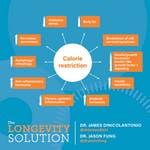
Calorie restriction can be considered a stressor and causes a rise in cortisol, commonly known as the stress hormone. This lowers inflammation and increases the production of heat shock proteins. Low levels of stress increases resistance to subsequent stressors. So, calorie restriction satisfies the requirements of hormesis. Because both exercise and calorie restriction are forms of stress, they involve the production of free radicals.
Hormesis is not a rare phenomenon. Alcohol, for example, acts via hormesis. Moderate alcohol use is consistently associated with better health than complete abstention. But heavier drinkers have worse health, often developing liver disease.
Exercise is well known to have beneficial health effects, but extreme exercise can worsen health by causing stress fractures. Even small doses of radiation can improve health where large doses will kill you.
Some of the beneficial effects of certain foods may be due to hormesis. Polyphenols are compounds in fruits and vegetables, as well as coffee, chocolate, and red wine, and they improve health, possibly in part by acting as low-dose toxins.
Why is hormesis important for aging?
Other theories of aging presuppose that all damage is bad, and accumulates over time. But the phenomenon of hormesis shows the body has potent damage-repair capabilities that can be beneficial when activated. Take exercise as an example. Weight lifting causes microscopic tears in our muscles. That sounds pretty bad. But in the process of repair, our muscles become stronger.
Gravity puts stress on our bones. Weight bearing exercise, such as running causes micro-fractures of our bones. In the process of repair, our bones become stronger. The opposite situation exists in the zero gravity of outer space. Without the stress of gravity, our bones become osteoporotic and weak.
Not all damage is bad - small doses of damage are in fact good. What we are describing is a cycle of renewal. Hormesis allows breakdown of tissue like muscles or bones that are then rebuilt to better withstand the stress placed upon them. Muscles and bones grow stronger. But without breakdown and repair, you cannot get stronger.
Growth vs. Longevity
Hormesis, like the disposable soma theory, suggests that there exists a fundamental trade-off between growth and longevity. The larger and faster an organism grows, the faster it ages. Antagonistic pleiotropy may play a role, in that some genes that are beneficial in early life may be detrimental later.
When you compare lifespans within the same species, such as mice, and dogs, smaller animals (less growth) live longer. Women, on average smaller than men, also live longer. Among men, shorter men live longer. Think about a person who is aged 100. Do you imagine a 6'6″ man with 250 pounds of muscle, or a small woman? Obesity, caused by excessive growth of fat cells, is clearly correlated with poor health.
Comparing across different species, however, larger animals live longer. Elephants, for example, live longer than mice. But this can be explained by the slower development of larger animals. The relative lack of predators for large animals has meant that evolution has favored slower growth and slower aging. Small animals, for example bats, which have fewer predators than other animals the same size, also live longer.
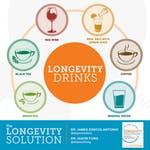
If you rev a car's engine very quickly, you can reach high speeds, but continuing to rev the engine will also result in burnout. It's the same essential program, but different timescales (short-term performance versus long-term longevity). All the theories of aging point out this essential tradeoff. This is powerful information because certain programs may be beneficial at certain times of our lives. During youth for example, we need to grow. During middle and older age, however, this high-growth program may cause premature aging, and it would be more beneficial to slow growth.
As the foods we eat play a large role in this programming, we can make deliberate adjustments to our diet to preserve our lifespan as well as our 'healthspan'. For more about healthy aging, check out my new book, The Longevity Solution.
Also published on idmprogram.com.
